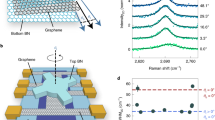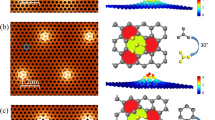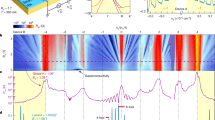Abstract
Spatially tailored pseudo-magnetic fields (PMFs) can give rise to pseudo-Landau levels and the valley Hall effect in graphene. At an experimental level, it is highly challenging to create the specific strain texture that can generate PMFs over large areas. Here, we report that superposing graphene on multilayer black phosphorus creates shear-strained superlattices that generate a PMF over an entire graphene–black phosphorus heterostructure with edge size of tens of micrometres. The PMF is intertwined with the spatial period of the moiré pattern, and its spatial distribution and intensity can be modified by changing the relative orientation of the two materials. We show that the emerging pseudo-Landau levels influence the transport properties of graphene–black phosphorus field-effect transistor devices with Hall bar geometry. The application of an external magnetic field allows us to enhance or reduce the effective field depending on the valley polarization with the prospect of developing a valley filter.
This is a preview of subscription content, access via your institution
Access options
Access Nature and 54 other Nature Portfolio journals
Get Nature+, our best-value online-access subscription
$29.99 / 30 days
cancel any time
Subscribe to this journal
Receive 12 print issues and online access
$259.00 per year
only $21.58 per issue
Buy this article
- Purchase on Springer Link
- Instant access to full article PDF
Prices may be subject to local taxes which are calculated during checkout






Similar content being viewed by others
References
Novoselov, K. S. et al. A roadmap for graphene. Nature 490, 192–200 (2012).
Castro Neto, A. H., Guinea, F., Peres, N. M. R., Novoselov, K. S. & Geim, A. K. The electronic properties of graphene. Rev. Mod. Phys. 81, 109–162 (2009).
de Juan, F., Mañes, J. L. & Vozmediano, M. A. Gauge fields from strain in graphene. Phys. Rev. B 87, 165131 (2013).
Vozmediano, M. A. H., Katsnelson, M. I. & Guinea, F. Gauge fields in graphene. Phys. Rep. 496, 109–148 (2010).
Guinea, F., Katsnelson, M. I. & Geim, A. K. Energy gaps and a zero-field quantum Hall effect in graphene by strain engineering. Nat. Phys. 6, 30–33 (2010).
Low, T. & Guinea, F. Strain-induced pseudomagnetic field for novel graphene electronics. Nano Lett. 10, 3551–3554 (2010).
Guinea, F., Horovitz, B. & Le Doussal, P. Gauge field induced by ripples in graphene. Phys. Rev. B 77, 205421 (2008).
Levy, N. et al. Strain-induced pseudo-magnetic fields greater than 300 tesla in graphene nanobubbles. Science 329, 544–547 (2010).
Jiang, Y. et al. Visualizing strain-induced pseudomagnetic fields in graphene through an hBN magnifying glass. Nano Lett. 17, 2839–2843 (2017).
Lee, C., Wei, X., Kysar, J. W. & Hone, J. Measurement of the elastic properties and intrinsic strength of monolayer graphene. Science 321, 385–388 (2008).
Geim, A. K. & Grigorieva, I. V. Van der Waals heterostructures. Nature 499, 419–425 (2013).
Yankowitz, M. et al. Emergence of superlattice Dirac points in graphene on hexagonal boron nitride. Nat. Phys. 8, 382–386 (2012).
Hunt, B. et al. Massive Dirac fermions and Hofstadter butterfly in a van der Waals heterostructure. Science 340, 1427–1430 (2013).
Dean, C. R. et al. Hofstadter's butterfly and the fractal quantum Hall effect in moiré superlattices. Nature 497, 598–602 (2013).
Mishchenko, A. et al. Twist-controlled resonant tunnelling in graphene/boron nitride/graphene heterostructures. Nat. Nanotech. 9, 808–813 (2014).
Xia, F., Wang, H. & Jia, Y. Rediscovering black phosphorus as an anisotropic layered material for optoelectronics and electronic. Nat. Commun. 5, 4458 (2014).
Li, L. et al. Black phosphorus field-effect transistors. Nat. Nanotech. 9, 372–377 (2014).
Appalakondaiah, S., Vaitheeswaran, G., Lebegue, S., Christensen, N. E. & Svane, A. Effect of van der Waals interactions on the structural and elastic properties of black phosphorus. Phys. Rev. B 86, 035105 (2012).
Wu, J. et al. Identifying the crystalline orientation of black phosphorus using angle-resolved polarized Raman spectroscopy. Angew. Chem. Int. Ed. 127, 2396–2399 (2015).
Pereira, V. M. & Castro Neto, A. H. Strain engineering of graphene's electronic structure. Phys. Rev. Lett. 103, 046801 (2009).
Artaud, A. et al. Universal classification of twisted, strained and sheared graphene moiré superlattices. Sci. Rep. 6, 25670 (2016).
Park, C.-H., Yang, L., Son, Y.-W., Cohen, M. L. & Louie, S. G. Anisotropic behaviours of massless Dirac fermions in graphene under periodic potentials. Nat. Phys. 4, 213–217 (2008).
Yoon, D. et al. Strong polarization dependence of double-resonant Raman intensities in graphene. Nano Lett. 8, 4270–4274 (2008).
Ferrari, A. C. & Basko, D. M. Raman spectroscopy as a versatile tool for studying the properties of graphene. Nat. Nanotech. 8, 235–246 (2013).
Kresse, G. & Hafner, J. Ab initio molecular-dynamics simulation of the liquid-metal–amorphous-semiconductor transition in germanium. Phys. Rev. B 49, 14251 (1994).
Perdew, J. P., Burke, K. & Ernzerhof, M. Generalized gradient approximation made simple. Phys. Rev. Lett. 77, 3865 (1996).
Miller, D. L. et al. Observing the quantization of zero mass carriers in graphene. Science 324, 924–927 (2009).
Li, S. Y. et al. Observation of unconventional splitting of Landau levels in strained graphene. Phys. Rev. B 92, 245302 (2015).
Song, Y. J. et al. High-resolution tunnelling spectroscopy of a graphene quartet. Nature 467, 185 (2010).
Gibertini, M., Tomadin, A., Polini, M., Fasolino, A. & Katsnelson, M. I. Electron density distribution and screening in rippled graphene sheets. Phys. Rev. B 81, 125437 (2010).
Castro, E. V., Cazalilla, M. A. & Vozmediano, M. A. Raise and collapse of pseudo Landau levels in graphene. Phys. Rev. B 96, 241405 (2017).
Slotman, G. J. et al. Effect of structural relaxation on the electronic structure of graphene on hexagonal boron nitride. Phys. Rev. Lett. 115, 186801 (2015).
Woods, C. R. et al. Commensurate–incommensurate transition in graphene on hexagonal boron nitride. Nat. Phys. 10, 451–456 (2014).
Müller, J. E. Effect of a nonuniform magnetic field on a two-dimensional electron gas in the ballistic regime. Phys. Rev. Lett. 68, 385–388 (1992).
Goerbig, M. O. Electronic properties of graphene in a strong magnetic field. Rev. Mod. Phys. 83, 1193 (2011).
Weiss, D., von Klitzing, K., Ploog, K. & Weimann, G. Magnetoresistance oscillations in a two-dimensional electron gas induced by a submicrometer periodic potential. Europhys. Lett. 8, 179–184 (1989).
Peeters, F. M. & Vasilopoulos, P. Quantum transport of a two-dimensional electron gas in a spatially modulated magnetic field. Phys. Rev. B 47, 1466 (1993).
Carmona, H. A. et al. Two dimensional electrons in a lateral magnetic superlattice. Phys. Rev. Lett. 74, 3009 (1995).
Matulis, A. & Peeters, F. M. Appearance of enhanced Weiss oscillations in graphene: Theory. Phys. Rev. B 75, 125429 (2007).
Roy, B., Hu, Z. X. & Yang, K. Theory of unconventional quantum Hall effect in strained graphene. Phys. Rev. B 87, 121408 (2013).
Acknowledgements
The authors thank L. Xin and Q. Su Ying for valuable suggestions. K.P.L. and S.A. acknowledge support from the Singapore Ministry of Education AcRF Tier 2 (MOE2017-T2-2-140).
Author information
Authors and Affiliations
Contributions
K.P.L. supervised the project. Y.L., K.P.L. and J.L. designed and performed the experiments. J.N.B.R., Y.Z.L. and E.L. performed calculations under the supervision of S.A. and Y.P.F. Y.L. and L.L. fabricated and measured the G–BP FET device. A.C. and M.Y. carried out DFT calculations under the supervision of A.H.C.N. and Y.P.F. J.L. helped to collect and analyse angle-resolved Raman experimental data under the supervision of C.H.S. H.X. Y.B. and Z.Q. helped to collect and analyse STM data. S.J.R.T. provided support for XPS and ARPES experiments. Y.L. and K.P.L. co-wrote the manuscript. All authors discussed the results and commented on the manuscript.
Corresponding authors
Ethics declarations
Competing interests
The authors declare no competing interests.
Additional information
Publisher’s note: Springer Nature remains neutral with regard to jurisdictional claims in published maps and institutional affiliations.
Supplementary information
Supplementary Information
Supplementary Figures 1–23
Rights and permissions
About this article
Cite this article
Liu, Y., Rodrigues, J.N.B., Luo, Y.Z. et al. Tailoring sample-wide pseudo-magnetic fields on a graphene–black phosphorus heterostructure. Nature Nanotech 13, 828–834 (2018). https://doi.org/10.1038/s41565-018-0178-z
Received:
Accepted:
Published:
Issue Date:
DOI: https://doi.org/10.1038/s41565-018-0178-z
This article is cited by
-
In-situ atomic level observation of the strain response of graphene lattice
Scientific Reports (2023)
-
Imaging quantum oscillations and millitesla pseudomagnetic fields in graphene
Nature (2023)
-
Strong second-harmonic generation by sublattice polarization in non-uniformly strained monolayer graphene
Nature Communications (2023)
-
Tunable bandgap of black phosphorus by arsenic substitution toward high-performance photodetector
Science China Materials (2023)
-
Lifting surface reconstruction of Au (100) by tellurium adsorption
Nano Research (2023)



